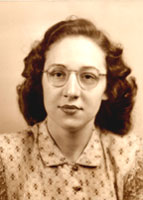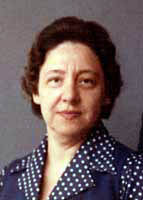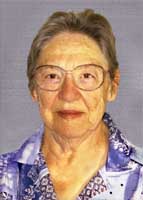About Jeannette Grisez

Jeannette 1950
When Jeannette Grisez (née Selby) was born prematurely on 10 February 1928 in Canton, Ohio, her prospects were poor. The first child of young parents, her life was saved only by the attentive and constant care of her maternal grandmother. Her father, Perl Selby, and his family, of English ancestry, worked in coal mines. The family of Jeannette’s mother, Bernadette Huppert, was of German ancestry and were farmers.
The Selbys were Methodists who despised Catholicism, and the Hupperts were Catholics. So, the families had hardly been pleased when Perl and Bernadette married on 11 May 1927 in the rectory of St. Joseph’s Church in Canton. Due to that tension, Jeannette was not baptized until she was five years old, and then it took her near death from a ruptured appendix to bring about the christening. Thereafter her parents supported each other’s practice of their respective faiths, and that fall they sent Jeannette—and later their three younger children—to parochial school. By then, Perl Selby had found work as a hammerman in a forge shop in Cleveland, Ohio.
Although barely old enough for the first grade in September 1933, Jeannette did well in school. As she was catechized year after year, so were her parents, and eventually her father was won over by a personable priest and received into the Catholic Church, to the dismay of his family of origin. Sister Mary Helene, S.N.D., Principal of Saint Gregory School and Jeannette’s fine eighth-grade teacher, was an exceptionally holy and happy religious sister. Like a spiritual mother, she nurtured Jeannette’s faith and self-confidence, and the two became lifelong friends.
Having heard good things about Andrews School for Girls in nearby Willoughby, Ohio, Jeannette’s parents sent her there for high school. Andrews was a private, nonsectarian boarding school, with a faculty-student ratio of about 1 to 10, yet it was affordable because well endowed. Able teachers of the core academic courses promoted reading comprehension, critical thinking, and clear and accurate writing. Vocational courses were available, and Jeannette acquired secretarial skills and studied retailing. The girls also were trained in housekeeping. Divided into small groups, each living in its own house, they took turns at every task, with the guidance and supervision of a housemother.
Though younger and more reserved than most of her classmates, Jeannette enjoyed her studies, acquired valuable skills, and made many friends. At the same time, she and the other Catholic girls received sound religious formation at a nearby parish, and Jeannette spent many weekends with her family. She graduated from Andrews on her eighteenth birthday, 10 February 1946, after completing both the academic program and a practicum in retailing—in shoes at Halle Brothers, a leading downtown-Cleveland department store.
After graduation, Jeannette continued working at Halles until October 1948. Her department manager liked her work and proposed that she become a buyer, but she wished neither to travel nor to make the difficult decisions buyers had to make. Living at home and helping with homemaking and the care of her youngest sister, then only two, Jeannette wanted a 9 to 5 job with a shorter commute. So, she became a secretary in the operating division of General Electric, which was much closer to home.
Most of Jeannette’s social life was with her extended family and many girl friends. But she sometimes dated and regularly participated in her parish’s young adults club, of which she became secretary-treasurer. The club sponsored a dance on Sunday, 1 May 1949, and invited members of similar groups from other parishes. Germain Grisez and his brother Mark, who had served in the U.S. Navy during the war, went to that dance. As they entered, the friendly and pretty cashier appealed to Germain. Noticing well after the music had begun that she was not dancing but was still sitting in the foyer to intercept possible latecomers, he struck up a conversation, then urged her to put the cash box in a safe place and dance with him. After some hesitation, she did. They enjoyed dancing and chatting, and, after a while, they changed partners. As the evening ended, Mark, who owned the car, suggested they give rides home to some of the girls they had met. Germain asked Jeannette; she accepted, and they took her home. A few days later he received an accurately addressed and neatly written thank-you note. She had memorized the spelling of his name and looked up his address.
Three weeks later, he called her, dropped by her home, met her family, and played with her baby sister. They began dating. Their friendship developed slowly; at first, they spent little time alone together, and it was a couple of months before they kissed. But as they became acquainted, they got along well. Jeannette listened carefully when Germain talked about his emerging vocation. Without grasping the details of his interests, she understood what he intended to do. When he told her in January 1950 about his hope to teach philosophy in a non-Catholic university, she was impressed and confident he would succeed.
The couple began considering the possibility of marrying, and by 1 May 1950 believed they would do so—eventually: Germain had years of graduate study ahead and, although he was draft-deferred during the Korean War, he expected to be called when his studies ended. But, regarding themselves as engaged, they arranged to get their marriage preparation out of the way during the 1950–51 academic year, while Jeannette remained in Cleveland with her family and Germain went off to study at River Forest, Illinois. They exchanged daily letters, and much of that correspondence was serious discussion about marriage and family life.
They found it hard to be separated during the fall semester. They missed each other, and Germain was homesick. Being together during Christmas vacation was comforting, but the following months were still harder. When Germain got home for Easter, they decided to marry in June, saw Jeannette’s pastor, obtained a marriage license, and then informed their parents. None was pleased, and all urged the young couple to wait. But they persisted, and Jeannette’s pastor urged their parents to cooperate with their plan to marry. Even so, when Germain returned to his studies, Jeannette’s parents pressed her to change her mind. But although she felt anguished, she was resolute, and the wedding took place on 9 June 1951, in St. Margaret Mary Church, South Euclid, Ohio.
They wore no special clothing; there were no social events; and they took no honeymoon. After a simple breakfast with their immediate families and other members of the bridal party, the couple spent the rest of that day preparing to leave their homes. That evening, Jeannette said goodbye to her father and mother, and the next day, Germain’s father took the newlyweds in his station wagon, loaded with their things, to their first residence, a shared apartment near the University of Chicago.
Rather than taking time to rest, they settled in and went to work. Jeannette at once got a job with the apparatus division of General Electric; Germain registered for his first quarter at the University and got a part time job; they opened a bank account with the few thousand dollars Jeannette had saved (Germain was broke); they began looking for a small apartment where they would have more space and privacy; and they made their first major purchase, a sewing machine. Having become a skillful seamstress, Jeannette was convinced they would save money and have better things if she made most of them.
Then, as during the next fifty-three years, Jeannette supported Germain’s work by going where it took him, making a home of the dwelling he was able to provide, and giving everything she had so that the family could live well and within its means. In February 1952, seven months pregnant, she quit her job at General Electric. She was to be a full time wife, mother, and homemaker for the next twenty-seven years. By the time the Grisezs left Chicago and Germain began teaching at Georgetown, he was deferred as a father from military duty. Both the couple’s advancement and their good marriage pleased their parents. Because they were moving to a suburb of Washington, Germain and Jeannette finally got a car, and they began to visit their families in Cleveland a couple of times a year.
Until 1959, Jeannette could not directly help Germain with his studies and work. But that summer, when he was completing his dissertation, she helped him type the final text, working day and night to meet the deadline for filing. Then, as he began publishing, she prepared the final manuscripts and helped proofread. When he wrote his book on contraception and, even more so, when he began research on abortion, she was interested in the subject matter. Discussing it with him, she asked good questions and made thoughtful comments.
When Germain left Georgetown, it was hard for Jeannette to move to far-away Saskatchewan. The move meant leaving not only familiar surroundings, the little house she loved, and the many friends she had made, but their two eldest boys, who were of age and chose not to abandon apprenticeships they had begun. When the Grisezs stopped on the way to Saskatchewan to visit their families, Jeannette’s father was in the hospital. No sooner had they arrived in Regina than she had to fly back to Cleveland for his funeral. But despite grief and anxiety over the problems of her two boys in Maryland as well as the two younger ones who had come with them, she was able to help Germain deal with serious depression he suffered in the winter of 1972–73.

Jeannette 1976
Recovering with Jeannette’s help, Germain did much more research and writing between May 1973 and June 1978 than he had done in all his years at Georgetown. Most of it was done in his study in their home in Regina. With her younger boys growing up, Jeannette now became more involved in his work and directly helped him in every way she could. The Grisezs spent much of the summers of 1973 and 1977 in rented quarters in Maryland. During the first, their younger sons and Jeannette vacationed while Germain worked; but during the second, the boys stayed in Canada, and Jeannette helped Germain work in libraries and meet with people from whom he was gathering information and ideas. Along with all the work they did during those years, the couple celebrated their twenty-fifth wedding anniversary in the summer of 1976 by taking their first real vacation without their children—the honeymoon they had forgone when they married—by driving a loop from Regina to San Francisco, the Pacific northwest, and back, visiting friends and sightseeing along the way.
In 1978, Jeannette was happy to give up her lovely home in Regina and return to Maryland, except that their third son remained behind in Saskatchewan, truck driving. As Germain prepared to draft the first volume of The Way of the Lord Jesus, they lived in a rented apartment, and Jeannette had some time to visit old friends and spend with her mother and her grandchildren. But she also spent many days helping him in libraries.
The Grisezs’ youngest son married in the summer of 1979, and beginning that September, when they moved to an apartment in a dormitory on the campus of Mount Saint Mary’s, Jeannette worked full time. As he drafted, she checked and retyped the manuscript, and made copies to distribute to his class. She also joined him in participating with the seminarians in daily Mass, Morning Prayer, and Evening Prayer; and she hosted many of them and most of his colleagues for snacks and meals in their apartment. She also kept track of expenses and made sure they were reimbursed.
As that year was approaching its end, they received a phone call from Regina on Monday morning, 24 March 1980: their truck-driving son had been killed when he tried to bypass a washout on a winter road and his rig slid backward and jack-knifed. They grieved, prayed, went on with their work, and buried him the following Saturday.
In the late spring of 1981, the Grisezs took a real vacation: four weeks in France. The first ten days were in Paris. Then they rented a car and drove to Tours, Lourdes, Avignon, Grenoble, Compagney (from which Germain’s great-grandfather had emigrated in 1833), Rouen, and back to Paris, where they spent the last few days celebrating their thirtieth wedding anniversary. That vacation was the first of several they took, every few years, from then on.
Later that year, with a grant from De Rance Foundation, they got a word processor, with a one-line display and an excellent daisy-wheel printer. Delighted because it enabled her to print out copy free of imperfections, Jeannette quickly mastered the program’s complexities, and rekeyed Germain’s revision of the entire manuscript. Once that was done, she had free time to undertake other projects, such as cataloging Germain’s growing collection of books, and making author, title, and shelf-list cards for each of them.
As they were finishing up work on Christian Moral Principles for its publication in 1983, admirers of Germain’s work arranged a lecture tour for him in Australia and New Zealand. Jeannette was also invited. That was the first of many working trips they took together, including to Rome in 1986, to England in 1997, and to many places in the United States.
When Germain began using a computer in the mid-1980s, Jeannette had less clerical work to do. But she was able then and later to discuss the concrete moral topics on which he worked, and he often clarified and developed his thought by talking with her. As the years went by, he received more and more telephone calls and letters, and she dealt carefully and kindly with everyone who tried to contact him. Moreover, she continued helping, as she always had, when there was proofreading or library work to do.
In those ways, Jeannette helped Germain with his work until he went to Houston on the morning of 27 January 2005. When he returned home the next evening, she was lying in a coma. She was rushed to the hospital emergency room. She had suffered a massive stroke soon after Germain had gone, and her brainstem was severely damaged. Although she recovered consciousness and was able to respond to questions by opening her eyes wide or closing them tight, she never spoke or smiled again. She died 13 February, three days after her seventy-seventh birthday.

Jeannette 2004
During the summer of 2004, the Grisezs had vacationed on the shore of Lake Superior in upper Michigan. On the way home, they stayed the night of 5 August in Gaylord, Michigan, and went to Mass in the Cathedral the next morning. It was the Feast of the Transfiguration. As they traveled that day, they did the Liturgy of the Hours and discussed a reading about our hope of sharing in the glory of the Lord Jesus. That evening, Germain took what turned out to be the last photograph of Jeannette.
|